We all know that warm air floats up to the ceiling and that the air coming from our windows is typically cooler and not very pleasant. Isn’t it great that both issues can be solved by just one heating device? A fantastic solution is to look for some of the best electric baseboard heaters out there.
Hot air comes from down under and when installed under a window, the heater ensures a warm draft. These and many more benefits are highlighted in our guide below. Check out the most popular products from that class and see which one will fit your needs.
Our article aims at giving you the most useful information in a concise fashion and this is why we also have additional maintenance and installation tips. Don’t wait and see exactly what we’ve prepared for you!
See The Quick Comparison Chart
What is a Baseboard Heater?
These devices aren’t the most expensive heating accessory you will buy for your home but there are a few things to consider. Here’s what pretty much all baseboard heaters have in common. They run entirely on electricity. The required circuit can be 120V, 208V, and 220V.
The costs of operating your baseboard heater will vary depending on the price of electricity in your community. They are usually used in a smaller home or as a secondary option. This is because the correlation between energy expenditure and heat isn’t the best when we discuss baseboard heaters.
Other common signs are related to installation. They all install against a wall and even if there’s a carpet – no problem. The heater will stay just above the level of the carpet for safety reasons. You will be able to find knockouts on the back of each unit. Screws go right through there and secure the product onto the wall.
Electricity can be put through any of the sides. Here’s where length matters. Typically, you will be able to find various sizes of each brand. Find the one which gives you the most efficient heating options for your room. You might need to buy several units.
A thermostat is used for control. That about ends all the similarities when it comes to this component. An electric baseboard heater with a built-in thermostat isn’t the only option of that class of heaters but we will talk about it below.
All such heaters operate by convection meaning that the heating element is made out of stainless steel. It will get hot and some warm air will gently take over the room. The safety element will shut off the unit once it gets too hot.
These are pretty much all the similarities when we talk about electric baseboard heaters. Now it is time to get more knowledge on all the variables. These next paragraphs will hopefully help you narrow down your selection depending on your own requirements.
Types of Baseboard Heaters
Getting to know the differences related to how baseboard heaters operate, are controlled or installed is one of the key factors when selecting one for your home. We will also mention electric baseboard heater efficiency in the sense that some units are more powerful than others. Whether this gives you an edge is something that we will discuss in the following section.
Thermostat
You will quickly understand that there are 2 main types of a thermostat and that goes for pretty much all sorts of heating and cooling devices you will be able to find out there. They are:
- Built-in thermostats
- Remote or wall-mounted thermostats
The first category is typically represented by a little dial located right on the front panel of your heater. In the case of baseboard heaters, you would usually have a “hi” and “low” setting. There might be some little positions in between and they will help you determine the amount of heat that you want to get.
This thermostat is perhaps not the better option of the two. A slight knock on it is that it is not as informative as you might want it to be. It is good for smaller rooms where you do not want to have so much exclusive control over the temperature.
Another reason why an onboard thermostat isn’t the best is that it will sometimes get “cheated” by the heater. An electric baseboard heater with a built-in thermostat will likely end up switching off more often than you’d like. The fact that the body of the device has reached a certain temperature doesn’t mean that the room has also achieved such values. Once the thermostat “feels hot” it will want to cool off and will turn the heater off. This is a great safety feature but it isn’t very practical when the room is still not as warm as you’d want.
A wall-mounted line voltage thermostat is the more sophisticated option. In fact, if you are asking the question “are new baseboard heaters more efficient”, the answer is “yes”. That’s because they do not come with a thermostat and your separately purchased wall-mounted controller will do all the magic.
You can adjust the exact temperature from your remote thermostat, check the time, set a timer, and even control a few heaters at the same time. Having the thermostat away from the unit will actually give you a better estimation of the room temperature. You know that when your heater shuts off, that’s because the temperature around the thermostat is truly at the value shown on the display.
Plug-in or Hardwired
You will very rarely encounter plug-in electric baseboard heaters but there are some. Actually, there is one on our top 6 list above. These units function in a way similar to a regular space heater. You can unplug them and move them to another room.
Furthermore, no installation is required as there is no wiring to be done. One drawback is related to safety because an outlet typically lies exposed. Water can get onto it or a child might play around it. The more power cords you have lying around, the more safety hazards that you have.
Now a hardwired baseboard heater will give you more peace of mind. There’s nothing to plug in or unplug. Additionally, there will be fewer wires to look at. Overall, a hardwired unit looks more visibly pleasing as it is simply cleaner. The fact that it is mounted adds to the sense of stability.
Yes, you can’t move it around and sometimes maintenance can be a challenge but you should be able to live with this trade-off. Another thing to consider is maybe getting a certified electrician to do the hard wiring. However, if you feel confident in yourself, you might even figure out how to install an electric baseboard heater on your own.
Classic or Hydronic Electric Baseboard Heaters
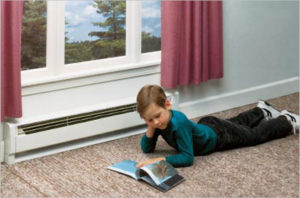
Regular/Classic Baseboard Heaters
Here we have a typical heat resistor and there are also fins. Electrical current goes through the fins and this is how they heat up. As they reach optimal temperature, they start emitting heat in the room and this is how the air gets warmer.
The biggest upside is that the air will get heated rather quickly in comparison to the second type of baseboard heaters. The moment you turn the device on, you will be able to feel some heat coming out through the front opening. Put your hand in front of it and notice the warmth.
On the negative side, however, balancing the temperature with a wall-mounted thermostat can be quite challenging. We already clarified how wall-mounted thermostats work. Since they have to “feel” the temperature before turning off, this holds some inconveniences.
Since the temperature of the air is measured, it will sort of mess with the wall-mounted thermostat. Once a certain threshold is reached, the thermostat will turn the baseboard heater off. The thing is that even if the air temperature drops by just 1 degree, the thermostat will turn the heater on. All of this will lead to some discrepancies in the temperature and that can happen on a regular basis.
Unfortunately, with a regular electric baseboard heater, the temperature of the air starts dropping rapidly if the device isn’t working. The fins start cooling off almost immediately after the electric current stops passing through them. This is easily seen the moment the thermostat shuts off the heater.
Hydronic Baseboard Heaters
Some people regularly label these devices like hot water baseboard heaters. In reality, though, these machines do not use water because it bears the danger of freezing if not used for long periods during the winter. They have a special heat fluid and their mechanics are similar to the finest oil-filled radiator heaters.
So in case you are asking what a hydronic baseboard heater is and how an electric hydronic baseboard heater works, we will give you a little bit more insight on the matter. Those heaters again have fins similar to the classic electric baseboard heaters. But here we also have a tube in which the magic happens.
The liquid gets heated and then it radiates heat to the fins. A benefit here is that the room gets warmer in a very even fashion. You will not notice sudden spikes and drops of the air temperature. Furthermore, if you shut the heater off, some residual heat will remain in place. The hot liquid will prevent the fins from cooling off immediately and this means that the room will stay warm for longer.
On the downside, these heaters will need longer to heat up the room. The liquid needs some time before it starts boiling. Then some more time will be needed for the fins to get hot. Only after all of this, some heat will start to be felt.
Best Electric Baseboard Heaters Comparison Chart
| PRODUCT | DETAILS | ||
|---|---|---|---|
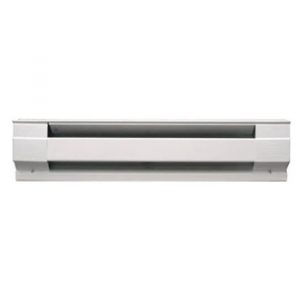 | Cadet Manufacturing White Baseboard Electric Zone Heater |
| View On Amazon |
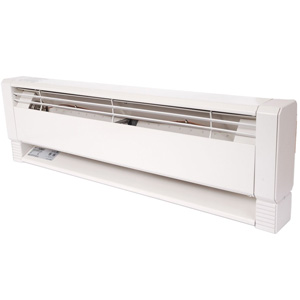 | Marley HBB Qmark Baseboard Heater |
| View On Amazon |
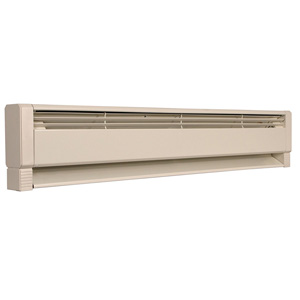 | Fahrenheat PLF1004 Baseboard Heater |
| View On Amazon |
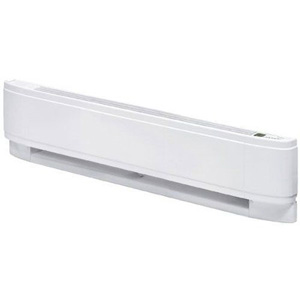 | Dimplex North America Wireless Baseboard Heater |
| View On Amazon |
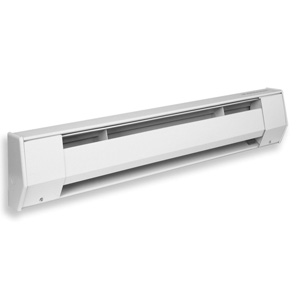 | King Electric Ceramic Baseboard Heater |
| View On Amazon |
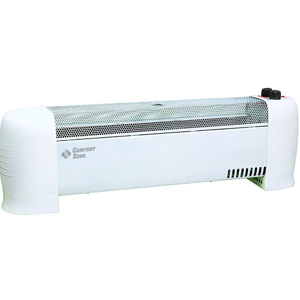 | Comfort Zone CZ600 Baseboard Heater |
| View On Amazon |
Best Electric Baseboard Heater Reviews (Top List 2021)
1. Cadet Manufacturing White Baseboard Electric Zone Heater
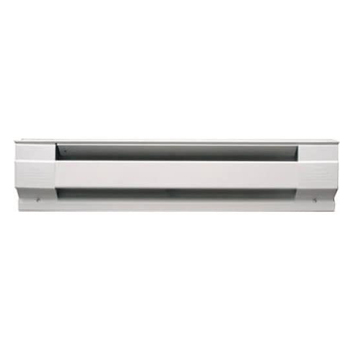
A thermostat is required, and you can put multiple heaters to it, just as long as you don’t overload your wiring. You can also wire to a double 20 or double 30-amp breaker. If you have a 30-amp breaker, you can wire three heaters.
The electric element Cadet heater, with its 750 watts, can warm up an area of 75sq. ft. It is designed for 240 volts and draws 3 amps, so as long as your insulation is good, you can rely on long-lasting, silent, and energy-efficient heat. The best result is usually achieved when the heater is placed under a window. The unit’s heat rises up to counteract with the incoming cold air thrusting it into the room.
The surface may get a bit hot for the sensitive child hands.
2. Marley HBB Qmark Baseboard Heater

When it comes to the type of circuit, the stock model comes at 120V. However, options such as 208V and 240V are also available. In order for rooms larger than 150 square feet to be heated, a few of these units would be required. It is completely compatible with a wall-mounted thermostat although one isn’t provided. There’s no noise coming from the heater and it will retain heat because of its metal body.
3. Fahrenheat PLF1004 Baseboard Heater

One can install the unit virtually in any room and this also includes bathrooms. It is compatible with only 240V circuits and needs to be hardwired. The length you get is not customizable and it stands at 46 inches. The BTU that one will be able to get from this product is about 3400. The maximum output is 1000W meaning that a room larger than 400 square feet would require about 4 of these. A wall-mounted thermostat is required for the proper operation of the unit. Auto-shutoff systems are present as well.
4. Dimplex North America Wireless Baseboard Heater

The unit has to be hardwired to a 240V circuit and comes with a built-in thermostat. This doesn’t limit it at all, however, as the Dimplex North America baseboard heater can also be synced with wireless temperature controls and wall-mounted thermostats. Another key feature of this product is the relatively short length. It can easily fit various interiors. The coating is epoxy/polyester and will likely smell a little the first few times the heater is used. Has a 10-year warranty.
5. King Electric Ceramic Baseboard Heater

There’s nothing to leak out or spill from the heater. This fluidless product will come a little cheaper than others but it won’t be as energy-saving as most hydronic baseboard heaters. One needs to purchase a separate wall-mounted thermostat. You wouldn’t expect that from most pure electric heaters as they typically have their own built-in temperature controls. The ceramic body allows for the distribution of convection heating. A room is slower to heat up but it does so evenly. You may also want to check out our reviews on top-rated ceramic heaters.
6. Comfort Zone CZ600 Baseboard Heater

It is among the best portable baseboard heaters as it can be moved to a room of your desire. Safety isn’t an issue as it has overheat protection and built-in temperature control. Safety tip-over “switch-off” is also part of the deal. The unit can be left unattended and still give you peace of mind. It works in a very silent fashion even though its maximum power output isn’t bad at all – 1500W. The lowest setting has it at 750W.
Here’s How to Install Your Baseboard Heater
We aren’t going to leave you to figure out how to mount your device on the wall yourself. This is why in this section you will become familiar with the universal way of installing your baseboard heater. We will kick off this part by reminding to read up on the following:
- Voltage
- Circuits
- Placement
- Clearance requirements
In case you are not familiar with any of the above, it is recommended that you hire a licensed electrician to do the installation. This is especially important if you are going to work with a live panel.
One of the more important tools to have is the stud finder. This machine shouldn’t be underestimated because its presence is crucial for your project. We will talk about it more below but before that, we will list the remaining important tools you need:
- Wire strippers
- Tape measure
- A drill
- Screwdrivers
- A meter
- Baseboard cutter
The first step is to route some power from your circuit panel. After that, a separate circuit will be needed in case you are also installing a wall-mounted thermostat but this is not going to be addressed here. Cut the breaker off because you cannot work with a live wire. Then, you need to know exactly where to cut the baseboards.
The future location of your baseboard heater is determined by using the stud finder. It will allow you to detect the exact placement of studs behind the wall. Since you want to screw the heater onto something strong, you want to see exactly where the studs are.
Firstly, take the measurement of the heater and copy it onto the trim. Secondly, use the baseboard cutter to get rid of the excess trim. If you don’t have that tool, you can also use a Dremel tool. Pre-drill your holes. You will use them when the time comes to attach the heater to the wall.
Get rid of the knockouts where the wire will go. Choose the side beforehand. What’s good about those modern-day baseboard heaters is that you get to select on which side the wires will go. If you forget to put the set nut on the wire before running the wire through the heater, you will need to detach the whole thing. So think about stuff in advance. Then, after the wire goes through the body of the heater, you are to install the strain relief connector.
Don’t forget the aesthetics part and make sure the heater is leveled. It will simply look plain ugly if you have one side higher than the other. This is when you use the pre-drilled holes. Secure the body to the wall and feel free to now remove the ground screw.
For more heater guides like patio heater reviews and bathroom heater reviews visit our homepage.
Maintenance & Electric Baseboard Heater Efficiency
No device will last longer if you do not take good care of it. Even if it does, it will start performing poorly over time in case no maintenance is performed. We will now talk about 2 of the most important things you can do to maximize the performance of your electric baseboard heater.
- Sealing it
- Disassembling and cleaning it
The good thing about the 1st point is that you do not really need to completely take apart your baseboard heater. You will not have to mess with the actual operational parts of the device. However, sealing the heater is an essential energy efficiency upgrade – one that shouldn’t be overlooked.
Firstly, remove the front and top covers of the baseboard heater. Then, nails and screws will also need to be taken out of there. Use pliers if needed. If the heater is stuck to the wall, this might be because of paint. You will need to use a utility knife in order to gently cut through the paint along the top of the heater.
Once the heater is loose, don’t take it completely out. firstly, just lift it a few inches and tack it in place on the wall because you want to have free access to it. Check out the condition of the vapor barrier. It is typically tight behind the sheetrock in case there is one. Remove the loose plastic parts of the vapor barrier so that the foam insulation can properly adhere to the wall.
Now you need the following:
- Plastic gloves
- A towel
- A foam gun
Use the top 2 supplies to make the procedure cleaner and safer. Run a line with the foam gun right where the wall and the floor are connected. Get rid of the nails you used to hold the heater up. Apply the old screws and nails and attach the heater back into place. Put back the covers and you are ready to go. There’s your insulated, sealed baseboard heater.
Delicate touch and impeccability are the deciding factors when we talk about disassembling and cleaning a baseboard heater. Most models have end caps on each side and that’s what you get rid of right away. They should just pop off as there are no screws or nails holding them tightly.
One can take the front panel out by hinging it outward. It will make a popping sound. That’s because along the length of the heater there are little hooks on the top and bottom which hold the front cover in place.
Once you have access to the fins, you are to dust them off carefully. Try not to apply any force there because you might bend them. After you have brushed the insides of the heater, you should also vacuum them. All the particles which have fallen on the ground or remain between the fins will be sucked in and away. Don’t use any water during this procedure! Make sure the baseboard heater is not turned on when cleaning it! Carefully assemble the covers back after you’re done.
Wrapping Up
Even though the best electric baseboard heaters sort of look similar, we made sure to distinguish the ones which are simply better than others. In our guide above, we outlined the main differences and benefits of utilizing a baseboard heater at home.
These universal devices are excellent for any room and we hope that we’ve steered you in the right direction when selecting one. Please give us your thoughts on the article and share it if you found it useful. In case you want anything improved, feel free to let us know by commenting. Thanks for reading and as always – stay put!
We have more reviews on our website like window fan reviews. Please check out in case you are interested.
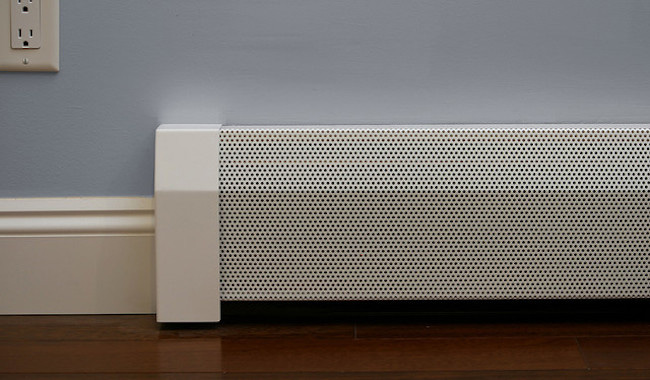
Leave a Reply